If you are a famous artist, then you may already have a concept worked out. However, many NFT projects are now in other categories. The major categories on Opensea: Art, collectibles, domain names, music, photography, sports, trading cards, utility, and virtual worlds. Many entrepreneurs are now looking at projects in which utility focus, then adding art, or gaming is the focus and then adding additional utility or a physical event or object to extend the NFTs concept.
Developing a compelling concept, in fact, is another of the most least understood parts of creating an NFT project.
There are all kinds of possible combinations, however, the overall concept will impact the messaging, brand, audience, and ultimately a successful launch.
Here are some ideas from successful NFT projects that appear most frequently in NFT online news sites and are top performers in the exchanges:
Artistic concepts
NFT art is still by far the largest category, with around 80% of the volume. Digital art was often known as graphic art, and therefore commercial rather than considered as fine art until the rise of NFTs and notable auctions like Christie’s and Sotheby’s took them on. In reality, the contemporary art scene already had a streak of digital art running through it; LA’s already hcontemporary arts museum featured light, video, virtual reality and digitial interaperability prior the NFT revolution and contemporary art museums across the country followed suit.
Today, however, digital art sales has democratized the art world. Theoretically, anyone who uses photoshop and illustrator for commercial work, can expand convert their ideas to an NFT format that will be taken seriously by the NFT community. In general, digital art tends to be more conceptual by nature. A Work created every day, over 1000 days. So for artists who want to work in this space, concept is particularly pertinent.
Here’s an example of a fine artist working with concepts in the NFT space successfully:
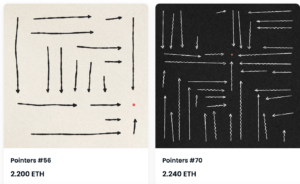
Pointers by Steve Pikelny. Project Description: A simulation of me sketching 100 variations of the same idea. My focus and attention to detail wane as the simulation progresses and its oppressive inevitability begins to sink in. By the end I find myself repeatedly asking: What’s the point of it all?
Note, this is a fine artist, with an artistic concept and a small number, ie only 100 items, 63 owners of whome, 63% are unique. Steve Pikelny has been experimenting with conceptual art and NFTs for a while, and is a master of concept. Here are a few of his 2022 projects:
This project was featured on OpenSea’s home page in mid-December, 2022.
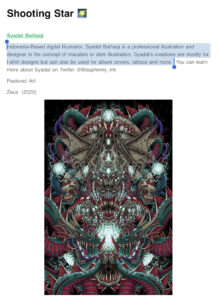
NFTEvening’s Shooting Star newsletter features an artists a day. Here is a brief description of this artist’s concept: Indonesia-Based digital Illustrator, Syadat Baihaqi is a professional illustration and designer in the concept of macabre or dark illustration. Syadat’s creations are mostly for t-shirt designs but can also be used for album covers, tattoos and more.
Lots of possibilities here. Baidhaqi issued an “open edition” (unlimited number of the same piece of art for a limited amount of time) priced at $12 for 4 days, and gained a following of 4000 on Twitter as a result.
Brand/Celebrity
Many well-known brands are now selling NFTs for promotion and/or add utility. Budweiser’s NFT project was unique piece of art that comes with a case of one-of-a-kind beer; 300 cases sold out. SMBs and venues such as Starbucks are already trying to use NFTs to extend their brands by creating a cache for tech-savvy customers, sending them wallet addresses with special accesses.
Even Tim Ferris, the author “The Four Hour Work Week” got into the action with CockPunch, an NFT that immediately took off:
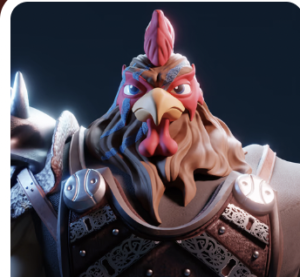
The Legend of COCKPUNCH™ is the tale of a fantastical realm, a universe of the bizarre from the mind of bestselling author Tim Ferriss. Artwork and stories are the gateway drug in this Emergent Long Fiction (ELF) project. Learn more at cockpunch.com.
Causes
Note that Tim Ferris’ project CockPunch has both a brand/celebrity to draw from, and also a donation to a cause:
Characters, maps, artwork, and more will be released over time.100% of NFT primary sale proceeds are being donated to the Saisei Foundation, a registered 501(c)(3) nonprofit private foundation that funds cutting-edge scientific research and other initiatives related to psychedelic medicine, mental health therapeutics, life-extension technologies, ecosystem conservation, indigenous knowledge preservation, and more.
The project successfully launched in early December, 2022.
Causes have long been a part of NFT marketing and beyond; just take note of the 2022 Tito’s bottles collared by a promotional card that says, “Vodka for dog lovers.” Some NFT websites have “manifestos” instead of white papers to convey that the project is value driven. Non-profits also have their own communities and mailing lists, and buyers may be as inspired as much by the cause as by the asset/utility. Once you’ve selected the type of cause to support, interview multiple recipients to find ones who have the largest, most engaged communities and who will support the project in other ways, with an e last, social media post or live event.
Historical firsts – NFTs are rife with examples of early projects that shaped the field historically: CryptoPunks, Rare Pepes, CryptoKitties, and Eggs to name a few. Coming up with a historical first today is still a valid concept since they are by nature marketing moments that are catnip for media, crypto newsletters social sharing.
Here’s how the Economist promoted what it claims was the first in the world NFT magazine cover:
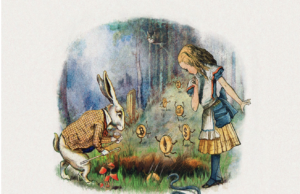
In September our “Alice in Wonderland” themed cover sent Alice down the rabbit hole, into the weird world of non-fungible tokens (NFTs), cryptocurrencies and blockchains. The new technology, the accompanying story argued, contained promise for all sorts of digital and financial activities. To grasp it better, we resolved to follow Alice down the rabbit hole. On October 25th we began an auction of an NFT of that cover. Just over a day later, after a flurry of late bids, the auction closed. It had raised 99.9 ether, equivalent to nearly $422,000 (see chart). The winning bid, less fees, transaction costs and potential tax liabilities, will be donated to The Economist Educational Foundation, an independent charity that teaches young people to analyse current affairs.
The project raised $422,000 for the foundation.
Not to be left in the dust, Time magazine followed with its own first in the world project:
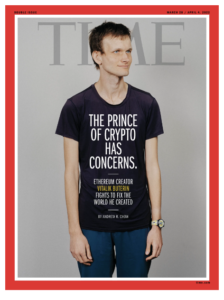
On Wednesday, TIME will release the first-ever fully decentralized magazine issue available as an NFT on the blockchain. The NFT issue features TIME’s cover story, The Prince of Crypto Has Concerns, on Vitalik Buterin’s fight for the future of Ethereum by Andrew Chow, editor of TIME’s Into the Metaverse newsletter.
Note also the collaboration that made this possible:
…The issue is created in partnership with the LITDAO. LIT is a web3 cultural currency and NFT project that conceived and created the first fully decentralized book earlier this year. The magazine will live on the blockchain but is hosted through a decentralized protocol allowing holders to read the magazine in its entirety through an interactive NFT. TIME will airdrop the NFT issue to select TIMEPiece and genesis LIT community wallet holders, which was made possible with the support of Circle.
Most NFT online newsites and newsletters are always on the look-out for these first-in-the-world launches.
- Built-in scarcity for the collection – Limiting supply is part of the concept for every project owner, since by nature there is only one. But the size of the collection also matters in limiting the supply. Delorean marked its 40 year anniversary with 40 1:1 NFTs created by a partnership with an artist:
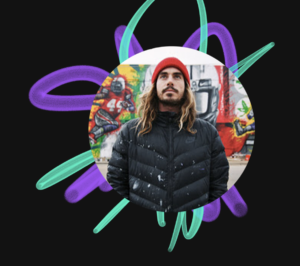
A known DeLorean enthusiast and friend of the DeLorean team, DeLorean tapped Madsteez to bring the 40th NFT collection to life. MADSTEEZ’s eclectic personality combined with the iconic silhouette of the DeLorean made each piece of art uniquely retro as they are modern for the ultimate collection.
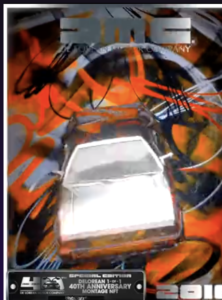
From its rise as a visionary car launch in the early 80’s to its inclusion in the iconic movie franchise Back To The Future, the DeLorean has one of the most storied motor vehicle legacies of all time. This year marks DeLorean’s 40th anniversary and to celebrate, DeLorean Motor Company has partnered with acclaimed street artist, MADSTEEZ, to create a revolutionary NFT series of 40 unique DeLorean 1-of-1 NFTs. The collection tells the history of the car via animated 3D NFTs, highlighting notable years with accompanying one-of-a-kind physical items.
So here you have another happy combination: A famous brand, possibility a world-first-of-its-kind NFT, and built in scarcity.
A real world physical component
Note that 3 NFTs in the DeLorean this collection include a restored 1981 car:
In addition to the 40 NFTs, the collection includes 3 special edition NFTs with incredible physical utilities. The crown jewel of the collection is a Special Edition DeLorean 1-of-1 Anniversary Montage NFT that comes with a fully restored original 1981 DMC-12.
Plus, NFT buyers got a spot on the wait list for the “hotly rumored” next Delorean to be manufactured:
In addition, the Special Edition: DeLorean ‘The Start of it All’ (1981) NFT will come with a spot on the DeLorean wait list for the hotly rumored but not confirmed, impossibly possible DeLorean redux. The Special Edition: DeLorean 1-of-1 ‘An Electrifying Future’ (2021) NFT is a unique work of art that is limited to just 1 edition and comes with a one-of-a-kind physical DeLorean x Super 73-S2 motorbike. Lastly, DeLorean partnered with digital racing game Riot Racers, to deliver two exclusive NFT cars that can be raced within the Riot Racers game, available on both the Special Edition: DMC-12: 2020, and the Special Edition: DeLorean ‘An Electrifying Future’ (2021) + Physical Motor Bike (DeLorean x Super 73-S2) (1-of-1).
Talk about FOMO; a Web3Collab member and accountant bought one of these for $25,000 after being unimpressed by anything else at the LA NFT convention, the largest in the world.
Physical items don’t have to be huge. Many creators are experimenting with unique physical objects that can be delivered afterward, which add cache and value. These can include amazingly packaged T-shirts, or even shoes printed with digital art, to display frames and more. In some cases, the NFT comes with a physical object that is more valuable than the NFT itself, such as a celebrity’s handbag. In this case, the NFT provides the provenance that the physical object belonged to the celebrity, especially in the case of resale, since the handbag is in fact a commodity and only the ownership is unique. Baidhaqi, for example, could develop the project further by partnering with a musician and include the art on a vinyl album cover, sent to buyers of the Olympian NFT project.
Licensing rights
While some exchanges such as OpenSea only offer the basic right to personal use in the NFT sales. There is no reason by an artist such as Baidhaqi could not include licensing rights to sell the art on a T-shirt, or for an musician to use on an album, or both. Solsea is one exchange that offers 9 different types of licenses in its template, and there is no reason a creator cannot put additional licensing rights in the unlockable content.
Community – Projects like Bored Ape Yaught Club are famous for finding ways to expand their brand by monetizing the desire of buyers to co-mingle with each other. Forming communities is powerful even for smaller projects, even if the community is simply a very active Discord group. But it can also include a virtual event, concert, or private owners-only discord as a way to add value to the concept. Keep in mind that OpenSea links directly to the Discord group, so even having a private meet the founder’s time on Discord, MeetUp or a local group may push an investor to get involved.
Utility
The final element of concept is utility. This category covers a lot of territory, memberships, ticketing and access to live and virtual events and games, consumer discounts and various types of clubs discussed in Module 1: How Value is created. Adding a utility element can boost ideas for partnerships that fuel community development.
A great example is Not a hotel – Membership:
MEMBERSHIP is an NFT that represents membership rights that is issued by NOT A HOTEL. This membership is valid for 47 years. One Day each year becomes a travel day. After making a purchase, one random date and time will be recorded on your MEMBERSHIP card. MEMBERSHIP holders can receive an NFT token called THE KEY via airdrop once a year.We offer MEMBERSHIP S which is for 1 night, MEMBERSHIP Y which can be used for 2 consecutive days and MEMBERSHIP X which can be used for 3 consecutive days. In addition to giving you 3 days of stay in the same location, MEMBERSHIP X also lets you use Exclusive House locations across Japan (fees apply).
Doing the research
This is a simple way of stating, figuring out how your project measures up against the competition and then strengthening the concept. The time to do some research is at the beginning, while the concept is being fleshed out. Start by researching the project on OpenSea and other marketplaces to see projects that are there, and following popular NFT newsletters and Twitter streams. Often, a first glance at OpenSea yields a lot of results, however, a deeper dive finds many of them, if not all, less than impressive. Look through the projects to see how yours fares. Here are some questions to ask yourself:
- What are similar projects?
- What do they offer? (Physical objects, licensing, utility, and so on)
- What are they selling for?
- How large is their community?
- Is the price rising or dropping?
- Are the founders well-known and doxxed?
- Are influencers listed on the website?
- Take a look at the website…. who are the founders?
- Is your formula stronger?
- What elements could you offer that would make your project 2x better.
- How could you develop the concept to make your project unique?
Gaining clarity
These are all elements to use in developing your concept, but at the end of the day, the concept needs to have a simple explanation that anyone can understand in a few sentences. Boil it to a short explanation suitable for the exchange.
Next module: Finding your target audience.

